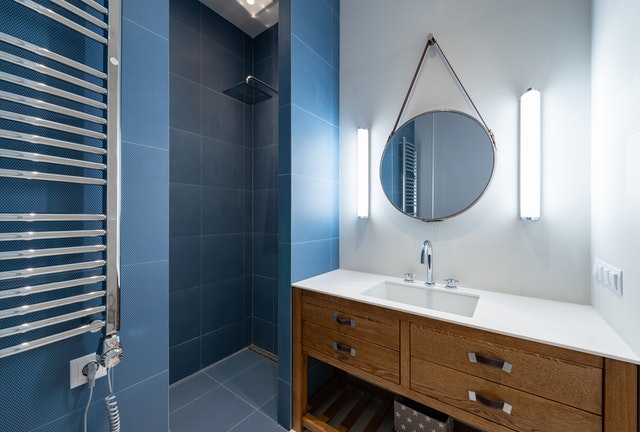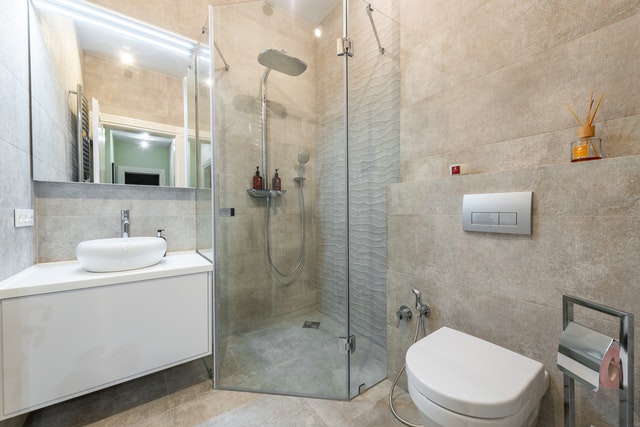This is an excerpt from the Book called “New Bathroom Idea Book” by Jamie Gold. Continue reading to learn more about Bathroom sink and Faucets, thanks to the author.
Fixtures And Faucets
Think back to the bathroom of your childhood. It probably had a basic tub and shower combination, a toilet, and shared sink. Until fairly recently, bathrooms were compact spaces to accomplish simple tasks.
That basic bathroom was a huge advancement from the shared washtub in the kitchen and outdoor plumbing of previous generations, but today’s homeowner has so many more choices. Bathrooms have evolved far beyond the basic into personal spas for master suites, style showcases for powder rooms, aging- friendly spaces for parents and in-laws, even fun spaces with flair for the younger members of the household.

Chances are, of all the bathrooms in your home, you’re going to make the largest investment in your master bathroom. Rather than a simple tub-shower combination, your master is more likely to have a separate soaking or whirlpool tub. Your toilet is more likely to have its own private room within a room and, potentially, bidet features. It will almost certainly use far less water than the toilet you grew up with; building codes are getting far stricter on this point. Your toilet may even have increasingly popular hands-free flushing or self-cleaning features.
Your needs, space, and budget should shape the choices you make in the bathrooms you remodel, but so should real estate trends in your neighbourhood in case you decide to sell your home.
Sink Types
Bathroom sinks come in several different types, with particularly, style, and budget often determining which ones you choose.
- Drop-in/top-mount/self-rimming sinks
These are typically the most affordable sinks with rims that sit on top of the counter and predrilling for faucets.
- Undermount sinks
These are designed to install under the edge of a vanity top for a more upscale look and easier maintenance. They are often paired with stone tops and are professionally installed. A variation on the undermount sink is the apron front, which has an exposed side for decorative purposes. It may also add increased size to the fixture with its extended façade.
- Console, pedestal, and wall-mounted sinks
What these have in common is that they don’t require a cabinet and countertop to rest on. Consoles with two or four legs are often selected for their aesthetic value, whereas wall-mounts are typically chosen for their compact size. Pedestals may be selected for both style and space reasons.
- Vessel and wading pool sinks
These style-forward sinks sit on top of a countertop. Vessels are often made of unique materials and tend to be highly decorative. Their bases can be difficult to clean around because of their shape, and they require wall-mount or special vessel faucets to accommodate their height. The self-rimming wading pool sink is really a shorter vessel that may be more comfortable for petite users.
- Integral sinks
Integral sinks are made of the same material as the countertop and typically have imperceptible seams where the edge meets the sink. They are often found in solid surface tops for budget bath projects, and in glass, porcelain, composites, engineered stone, and concrete for upscale spaces.
Sink Materials
- Ceramic
Ceramic, especially vitreous china is one of the oldest and most common bathroom sink materials. It is easily cleaned, but also easily chipped or cracked. Some new pricier versions have very durable, ultrathin sides.
- Cast iron and cast steel
Cast iron is also a very old material and one of the most durable. It includes a metal core and high gloss enamelled surface. Today’s leadless cast iron won’t necessarily perform quite like Grandma’s did, though, and may rust at drain and faucet connection points.
Cast iron’s heavy weight is another drawback, and has given rise to the cast steel sink. The core metal is lighter, more flexible stainless steel. These can be installed without bracing but are likelier to crack than cast iron.


- Solid surface, resins, and composites
The popularity of solid surface countertops has led to the integral solid surface sink with its low-maintenance seamless appearance. Despite their soft feel, these sinks are fairly durable and repairable if damaged.
Resins and other man-made composite materials are also molded into integral sinks. These range from affordable cultured marble sets to fashion-forward troughs. Their blend of engineered materials creates a countertop and fixture with smooth and easy-clean surfaces.
- The exotics
Sinks can also be made from glass, natural stone, copper, pewter, bamboo, and even wood. Glass is among the most common, with the lowest maintenance, and is more durable than its reputation would imply. Natural stone, copper, wood, and concrete, on the other hand, require regular maintenance.
Sink Faucets
Like sinks themselves, the faucets that serve them come in multiple formats, materials, and price points. If you’re just replacing a faucet, not remodelling the sink area, look for a model that will fit the same holes. You have more options today than in the past. Manufacturers have learned that not everyone wants their faucets spreads to be predetermined at a standard 4 or 8 inches. Flexible water and connecting lines and interchangeable parts are also included in some packages to allow for customization at the time of installation.
- Faucet Types
The most common are 4-inch centers, 8-inch centers (also called widespread), single hole, and wall-mount. Wall-mounted faucets are harder to replace. In addition to differing installation types, there are also differences in handle types, from aging-in-place-friendly lever handles to knobs and cross-hatches.
There are also new hands-free faucets that can be turned on with an arm tap or wave motion, but you will need to manually adjust their temperature and flow rate.
- Faucet Materials
Faucets may be clad in metal, resin, or combination finishes, but their construction is commonly solid brass or a brass substitute with other non-corrosive materials. Flow regulators can be rubber O-rings inside a brass cartridge, ceramic disks, or metal or plastic balls. The best quality faucets will generally be solid brass constructions with ceramic disks.
Finishes vary widely. Brushed nickel, oil-rubbed bronze, and polished chromes are among the most widely available and affordable, but other metals, spot-resistant treatments, and even composite faucet finishes are gaining popularity.






